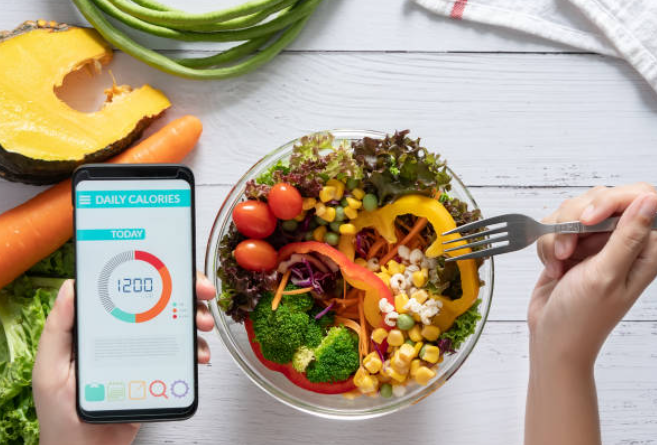In our journey towards optimal health, decoding the intricacies of calorie management is paramount. This guide aims to provide precise insights into caloric needs, shedding light on the science behind weight management and offering practical tips for a balanced lifestyle.

THE BASICS
At its essence, a calorie signifies the energy required to raise 1 gram of water by 1 degree Celsius. For adults, daily caloric requirements range from 1,600 to 3,000, influenced by factors such as age, gender, height, and lifestyle. This fundamental understanding sets the stage for effective caloric navigation.
WEIGHT MANAGEMENT
The quantity and typeof the food individuals ingest play a crucial role in determining their caloric intake. If an individual consistently exceeds their energy needs, they’ll gain weight. Conversely, a reduction in consumption will lead to weight loss, including fat and, eventually, muscle mass. The 2020-2025 Dietary Guidelines for Americans offer personalized calorie ranges, forming a foundational guide for weight maintenance.
Age Calories (males)
16–18: 2,400–3,200
19–20: 2,600–3,000
21–35: 2,400–3,000
36–40: 2,400–2,800
41–55: 2,200–2,800
56–60 : 2,200–2,600
61–75: 2,000–2,600
76+: 2,000–2,400
Age Calories (females)
16–18: 1,800–2,400
19–25: 2,000–2,400
26–30: 1,800–2,400
31–50 : 1,800–2,200
51–60: 1,600–2,200
61+: 1,600–2,000
For the human body to function and survive, it requires energy, with the brain alone consuming approximately 20% of the metabolic energy derived from food. The Basal Metabolic Rate (BMR) constitutes the primary component of a person’s energy needs, representing the energy necessary for basic life functions like blood circulation, digestion, and breathing.
Health professionals refer to the total energy utilization as energy expenditure, which encompasses the BMR, the thermic effect of food (energy needed for digestion and absorption), and energy use through physical activity. To maintain body weight, individuals need to strike a balance between the energy derived from food and the energy they use. Consequently, those aiming for weight loss often increase physical activity to surpass their energy intake, creating a calorie deficit.
As a result, it is unlikely that a person could accurately calculate their BMR at home. As a simpler alternative, people can try calculating their resting metabolic rate (RMR). The RMR estimates the number of calories a person burns during a period of inactivity
One useful way of estimating RMR is the Mifflin-St. Jeor equation:
Male: 9.99 x weight (kg) + 6.25 x height (cm) – 4.92 x age + 5
Female: 9.99 x weight (kg) + 6.25 x height (cm) – 4.92 x age – 161

TIPS:
- Mindful Eating: Opting for nutrient-dense foods supports overall well-being.
- Regular Meals: Balanced meals throughout the day regulate metabolism and prevent mindless snacking.
- Hydration Matters: Water is a healthy alternative to sugary beverages.
- Incorporate Fiber: Foods rich in fiber contribute to a sense of fullness and aid digestion.
- Physical Activity: Regular exercise complements overall health and balances caloric intake.
Activity Calories burned:
Lifting weights 90
Aqua aerobics 120
Walking at 4 miles an hour 135
General swimming 180
Running at 6 miles an hour 495
General gardening 135
Sleeping 19
Maintaining a healthful diet goes beyond merely restricting calorie intake, as various foods impact the body differently. While counting calories aids in weight management, the visual representation of 100 calories can vary significantly based on the food source. For instance, 100 calories from items like chips, chocolate, or cake represent smaller portion sizes compared to 100 calories from fruits or vegetables.
Rather than fixating solely on calorie counting, individuals should prioritize a balanced dietary plan, ensuring adequate consumption of each macronutrient and food group. General guidelines recommended are incorporating five servings of fruits and vegetables daily while restricting overall energy intake from free sugars and fats.
EUROPEAN PERSPECTIVE
Simple recipes for a lunch under 600 calories according to foodspring.fr
- Chicken and leek crumble
- Beef and eggplant burger
- Ricotta Gnocchi
- Bordeaux-style salmon
- Carrot and Ginger Soup
- Tuna pasta
- Potato and celery rostis
- Sliced Chicken Tacos
- Black bean toast
- Vegan quiche
source: https://www.medicalnewstoday.com/articles/245588#faq & https://www.foodspring.fr/magazine/recettes-dejeuner-peu-caloriques



